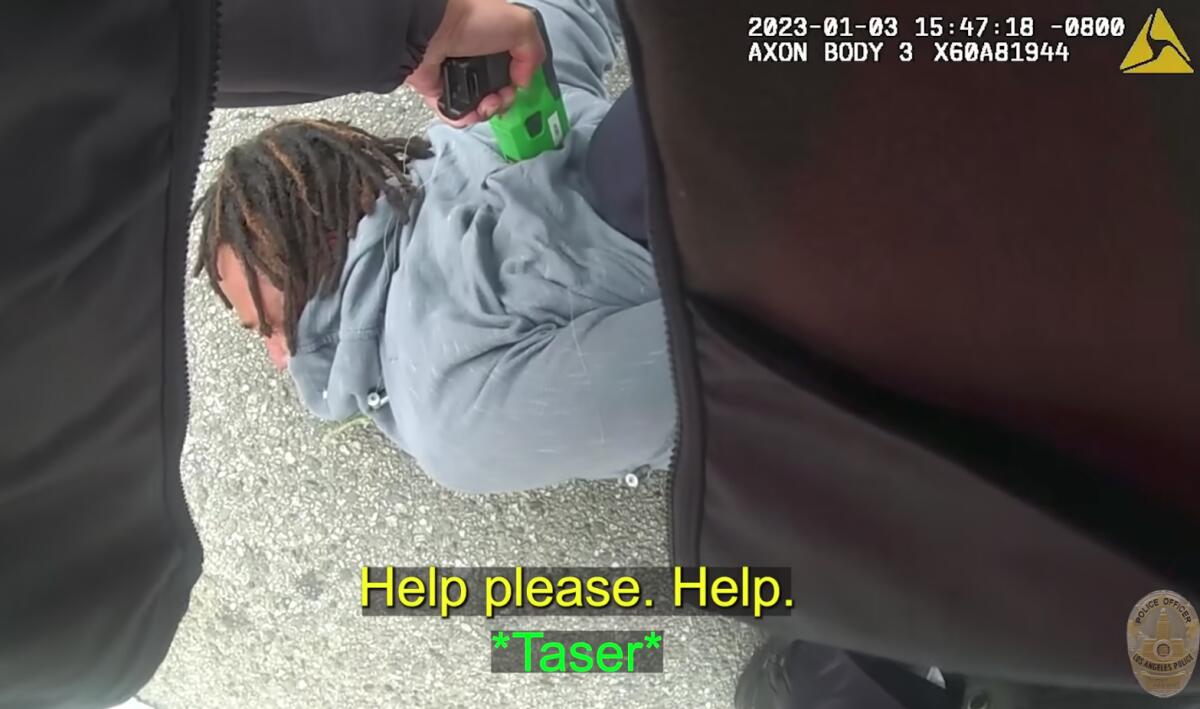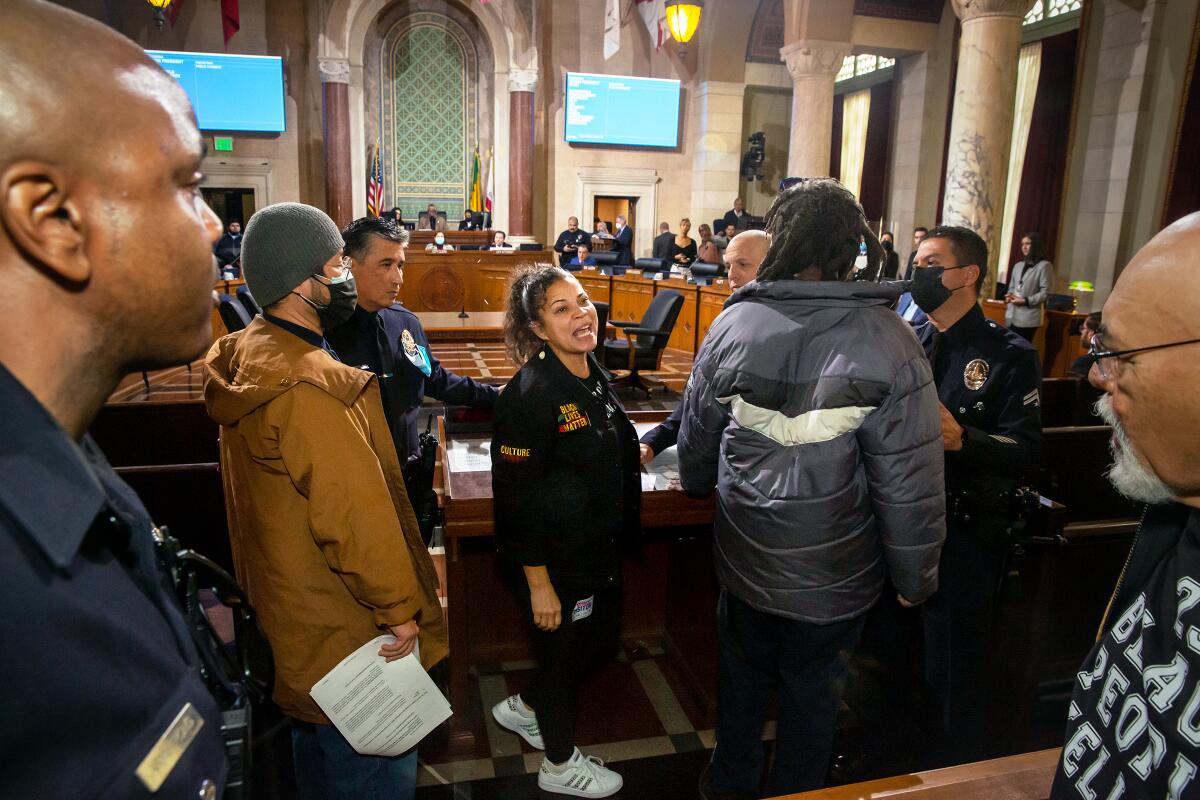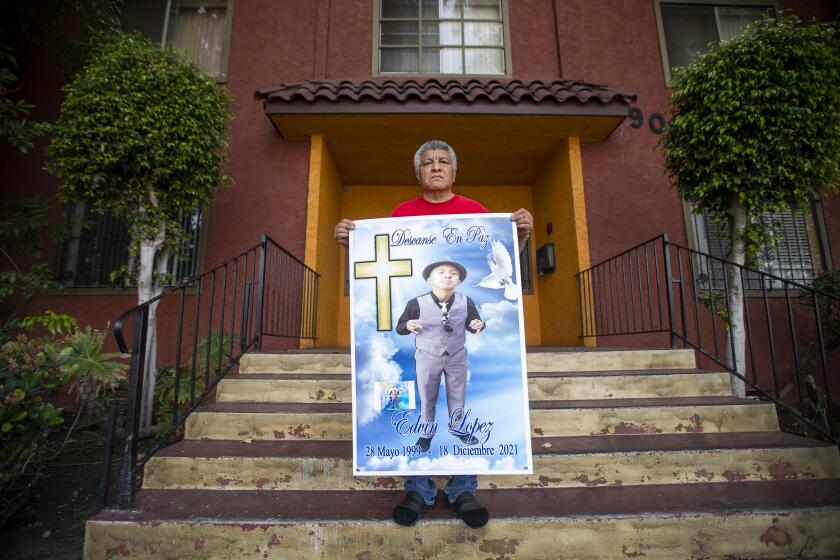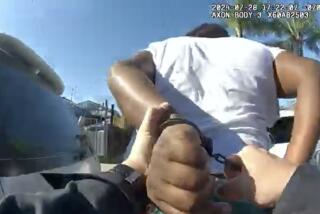LAPD’s repeated tasing of teacher who died appears excessive, experts say

- Share via
Videos released this week of a teacher who died after Los Angeles police discharged a Taser on him at least six times on a Venice street raise serious concerns about the officers’ tactics, law enforcement experts who reviewed the tapes said.
The LAPD’s actions have sparked alarms from community activists as well as Mayor Karen Bass and are now the subject of an internal investigation.
Several policing experts who reviewed the videos for The Times said that the amount of force used by the officers seemed excessive given the man’s actions and that some of the tactics seemed haphazard.
“It is going to be hard to convince any judge that these officers were using reasonable force,” said Ed Obayashi, a Northern California deputy and a top state advisor on police tactics. “From the visual aspect, it looks like he is not fighting back; he is not threatening the officers. He is saying I am not resisting ... and what could be considered resisting is an automatic reflex of the body to the pain application from the Taser.”
LAPD Chief Michel Moore addressed the three deaths at Tuesday’s meeting of the Police Commission, promising to make public body-camera footage the following day.
In the videos, Keenan Anderson, 31, becomes distraught and cries out for help as multiple officers hold him down.
“They’re trying to George Floyd me,” he screams, referencing the Minneapolis man killed by police as one officer briefly has his elbow on or around Anderson’s neck as he is held down on the blacktop.
Eventually, he is handcuffed and hobbled at his ankles before paramedics take him away. Four hours later, he died at the hospital. A cause of death has not been established.
The incident began Jan. 3 at 3:30 p.m. with a motorcycle officer arriving at what the LAPD characterized as a “felony hit-and-run” car crash at Venice and Lincoln boulevards. Police said Anderson was in the middle of the street, declaring, “Please help me.” LAPD Chief Michel Moore alleged this week that another driver reported that Anderson had attempted “to get into another car without his permission.”
Anderson then wanders in and out of cars, with the officer telling him to get on the sidewalk, according to the video. The officer yells, “Get up against the wall.”
Anderson then holds up his hands. “I didn’t mean to. I’m sorry.” Anderson sits down on the sidewalk.
After a gap of several minutes, Anderson declares, “I want people to see me,” and “you’re putting a thing on me.”
In recent shootings, LAPD officers have repeatedly fired live rounds and ‘less lethal’ alternatives simultaneously, without allowing the less-lethal rounds to take effect first.
That is when Anderson gets up and runs back into the roadway, according to the video. When Anderson stops, an officer says, “Turn over on your stomach.” As a swarm of officers moves in, Anderson cries out to onlookers, “Please help me,” and says the officers are “trying to kill me.”
Officers then attempt to pin him down. One can be seen on the video placing his elbow on Anderson’s neck while he lies on his back. The officer standing above him shouts, “Turn over, or I’m going to tase you.”
The officer then fires the darts of the stun gun into Anderson’s back and pulls the trigger, attempting to discharge the muscle-constricting electrical pulse. He discharges the Taser twice and then applies the Taser in stun mode directly to Anderson’s back at least four times.
Moore said data from the Taser weapon showed “there were six separate activations over 42 seconds. The first two [were] in the probe mode. We believe the darts weren’t effective. Then four activations over 33 seconds” in the stun mode in which the pulse was applied directly to the skin.

Walter Katz, a former independent police auditor in California and Chicago, said it’s up to the coroner to determine the role of the Taser in Anderson’s death, but either way that doesn’t mean the officer’s actions were appropriate.
Katz said the incident begins to go wrong when the officer with the Taser directs Anderson to turn over on his stomach and stop resisting.
“The first application of Taser is in such a way that if effective contracts the muscles so the person cannot move and makes them unable to comply with that order,” he said.
As two Los Angeles police officers wrestled with a vandalism suspect, one grabbed her Taser and pressed the stun gun against the 38-year-old man’s body.
Then, Katz said, the officer used the Taser on Anderson’s body repeatedly without really giving the man the chance to reset. Katz said it should have been clear by that point that Anderson’s behavior suggested he was somehow impaired.
“To do more tasering to me was a poor decision,” he said. “This officer went down the path of this is the tool I am going to use.”
Under LAPD policy, “there is no preset limit on the number of times a Taser can be used in a particular situation; however, officers should generally avoid repeated or simultaneous activations to avoid potential injury,” Moore said.
The chief alleged that Anderson was in an altered state and resisted officers’ efforts to detain him. His bloodwork showed the presence of cocaine and cannabis in his system, Moore said.
Moore said one officer’s “elbow appears to be along the collar bone and may have touched the neck or not, but I hear, ‘Partner your elbow.’” The chief said there is no evidence of Anderson’s airways being compromised.
Timothy T. Williams, a use-of-force expert and former supervisor with the LAPD elite Robbery Homicide Division, said he was also concerned about the tactics.
“The tasing was, in my opinion, excessive force. You use the force which is necessary. You don’t hold a Taser on a person that length of time to control him or her,” he said.
Police had enough officers, Williams said, “to get him turned over and handcuffed and sat up.” He said the first motorcycle officer did the right thing by calling for backup. But in the slow-evolving incident, he never heard anyone call for the department‘s mental evaluation team, which specializes in handling people suffering a mental health crisis.
Carl Douglas, a well-known civil rights attorney representing some of Anderson‘s family members, said the officers failed to consider Anderson’s mental state and did not follow appropriate tactics and policies.
“Several officers are working independently here and not as a team,” Douglas said. “He repeatedly tased him in the back of his heart.”
Anderson was a 10th-grade English teacher at a public charter school in Washington, D.C., and had a 5-year-old son. He was in Los Angeles visiting family and moving his belongings back to the nation’s capital, Douglas said.
Anderson is the cousin of a Black Lives Matter co-founder, Patrisse Cullors.
“As I watched the video, what was clear to me is that my cousin, Keenan, was actually really scared and he was asking for help repeatedly and unfortunately that’s not what he received from LAPD,” Cullors said. “At that point the question becomes why wasn’t there [help]?
“Why wasn’t my cousin offered medical attention?” she asked. “Why wasn’t there an ambulance or fire department called if he kept repeating that he needed help, that he needed support?”
Before watching the body camera footage, Cullors told The Times that she and her family were still trying to piece together what happened.
“What we do know is that Keenan was alive before his experience with the police and then he was dead. But we don’t want to continue with the narrative of what the police were saying because we don’t know if that’s true,” she said.
The LAPD uses the Taser, a brand of stun gun produced by Axon Enterprise, formerly known as Taser International. The name Taser has become synonymous with the stun gun. The department has long used this and other so-called less lethal weapons. But a Times investigation in 2016 found that of the 1,100 times an LAPD officer used his or her Taser, the weapon worked just 53% of the time. Taser deployments fell from 1,363 in 2016 to 545 in 2020, the most recent year for which the LAPD has released reliable data.
The city has also paid civil settlements as a result of its use. In 2020, the city approved a $5.75-million settlement with the parents of a 39-year-old Marine veteran who died after an LAPD officer stunned him six times with a Taser during a 2014 Christmas Eve altercation. A Los Angeles County coroner’s report determined that his death was a homicide and that he died from ventricular dysrhythmia because of an enlarged heart and noted that cocaine intoxication and police restraint by a Taser were contributing factors.
An investigation by Reuters has examined records of more than 1,000 people who have died in the United States after encounters with police in which Tasers were used either on their own or, more often, as part of a larger use of force. According to the 2017 investigation, medical examiners cited the Taser as a cause of death or a contributing factor in at least 153 cases. A U.S. Department of Justice-funded study found that 99.75% of field uses of stun guns resulted in no injuries.
After the footage was released with the two other videos showing LAPD officers fatally shooting two men, newly elected Mayor Karen Bass said she had “grave concerns about the deeply disturbing tapes.”
“Full investigations are underway, and I pledge that the City’s investigations into these deaths will be transparent and will reflect the values of Los Angeles,” the statement said. “I will ensure that the City’s investigations will drive only toward truth and accountability. Furthermore, the officers involved must be placed on immediate leave.”
L.A. County Dist. Atty. George Gascón said that once the LAPD investigation is completed, his attorneys will “conduct our independent analysis of all available evidence.
“My heart goes out to his family and everyone who knew him,” he said. “Police encounters that end in death leave our communities reeling with grief and sadness.”
Times staff writer Libor Jany contributed to this report.
More to Read
Sign up for Essential California
The most important California stories and recommendations in your inbox every morning.
You may occasionally receive promotional content from the Los Angeles Times.













